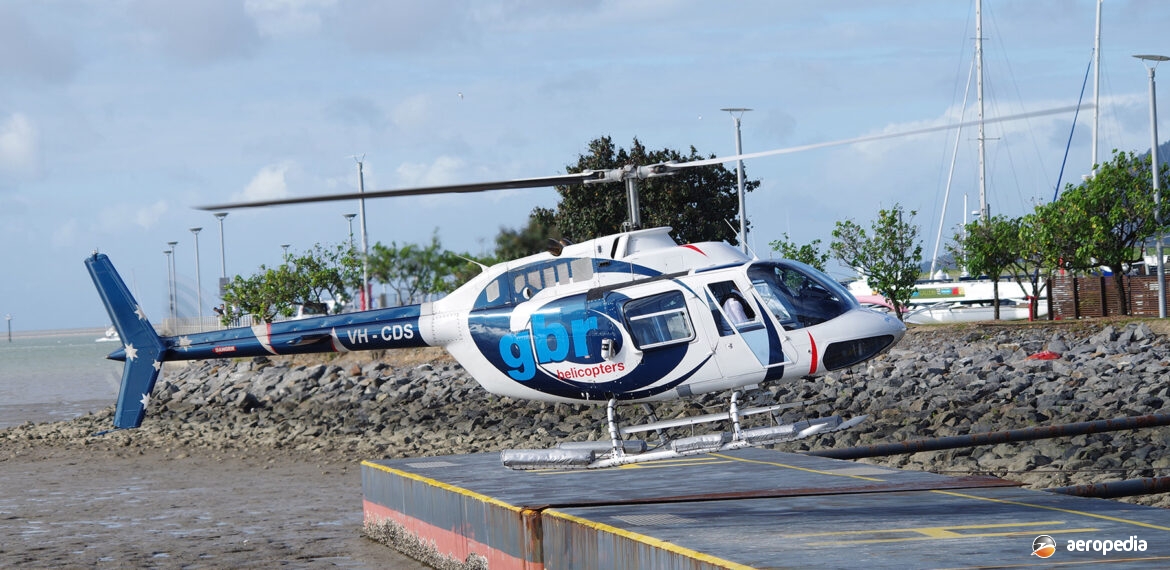Photograph:
Bell 206B JetRanger III VH-CDS (c/n 2446) at Cairns, QLD in July 2015 (David C Eyre)
Country of origin:
United States of America
Description:
Light utility helicopter
Power Plant:
(206B JetRanger III)
One 313 kw (420 shp) Allison 250-C20B turboshaft
Specifications:
- Rotor diameter: 10.16 m (33 ft 4 in)
- Fuselage length: 9.5 m (31 ft 2 in)
- Main rotor disc area: 81.1 m² (872.7 sq ft)
- Max speed at sea level: 225 km/h (140 mph)
- Max cruising speed at sea level: 214 km/h (133 mph)
- Hovering ceiling in ground effect: 3,871 m (12,700 ft)
- Initial rate of climb: 469 m/min (1,540 ft/min)
- Max range with no reserves: 579 km (360 miles)
- Empty weight: 680 kg (1,500 lb)
- Loaded weight: 1,451 kg (3,200 lb)
History:
The Bell 206 JetRanger series of light helicopters was one of the most successful machines to be built in its intended role, and some 7,700 examples have been built for civil and military operators in a variety of models. In addition, licence production was carried out in Australia by the Commonwealth Aircraft Corporation, and in Italy as the AB-206 by Agusta.
The JetRanger, the prototype of which was flown for the first time on 10 January 1966, was a commercial derivative of an unsuccessful entry by Bell to the US Army light-observation helicopter contest. This was won by a variant of the Hughes 500. Powered by the Allison 250-C18 turboshaft of 236 kw (317 shp), deliveries of the first production JetRanger, the 206A, began at the end of 1966. Lighter and faster than its predecessor, the OH-4A, the JetRanger had an entirely re-designed fuselage resulting in a reduction of 70 kg (155 lb) in empty weight. The 206A, which in the event was also ordered for the US Army as the OH-58A Kiowa, had a larger rotor of 10.77 m (35 ft 4 in) in diameter, and a fuselage length of 9.84 m (32 ft 3½ in).
On 18 February 1971 the Australian Government ordered 196 Bell 206B-1 helicopters to be built under licence by the Commonwealth Aircraft Corporation. A total of 75 was to be built for the Australian Army and the others were to be sold to civil operators in the Pacific region by the local agents, Bell Helicopters Australia. In the event only 56 were built, and the Australian Army and the Royal Australian Navy eventually received all produced. The Australian-built machines were specifically for operations at high temperatures and high altitudes. Fitted with the C-20 version of the Allison 250 engine, these helicopters had longer high-inertia rotor blades, a low-speed transmission, and slightly longer undercarriage legs.
In 1971 the up-graded 206B Jetranger II was released with the up-rated 313 kw (400 shp) Allison 250-C20 turboshaft, and minor improvements. This helicopter could seat five in a normal passenger layout. Conversion kits were made available to bring Model 206As up to this standard.
Next variant was the Jetranger III with the 313 kw (420 shp) Allison 250-C20B engine, and yet another conversion kit was offered to up-grade earlier models. In 1986, Bell transferred production of the series from its Texas facility to its Mirabel facility in Canada. Production and development continued up to the 206B-3 Jetranger III.
More than 220 examples have been registered in this region, with 42 presently registered in New Zealand and 137 in Australia.
Sydney businessman, Richard ‘Dick’ Smith, between 5 August 1982 and 22 July 1983, completed an adventurous solo round-the-world flight in his Bell 206 Jetranger III VH-DIK (c/n 2653), covering 56,742 km (35,258 miles). In 1987 he flew the machine to the North Pole. Total flying time of the round-the-world flight was 320 hours, averaging 177 km/h (110 mph). This machine was later placed on display at the Sydney Power House Museum.
The Bell 206 series has been used extensively in this area for a variety of roles, including charter work, tourists flights, fire-bombing, search-and- rescue, and crop-spraying, and by various police and television station services. In 2018 the type was being retired from Australian Army service and sold off, a number going to aviation museums and others being refurbished and placed on the Australian Civil Aircraft Register.

